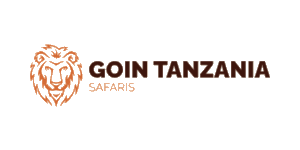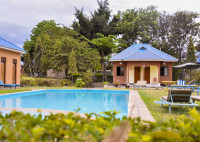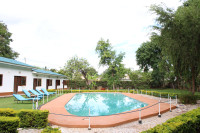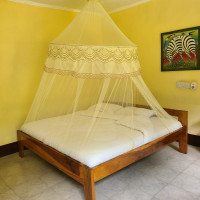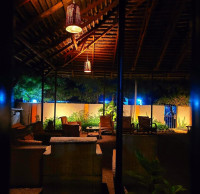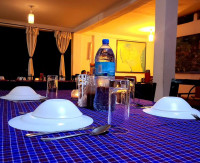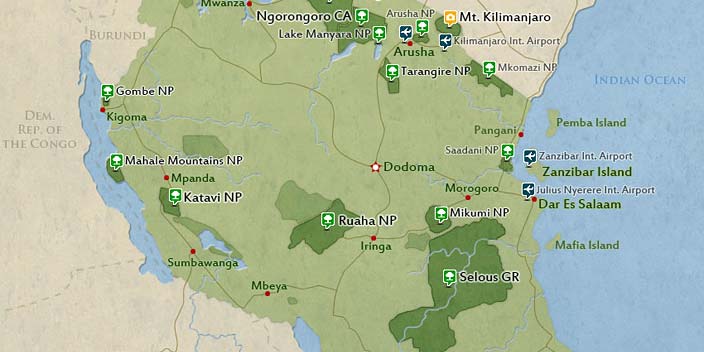
$1,070 pp (USD)
2 travelers on Start dateArrival
Arrival

Day 1
Tarangire National Park
Tarangire National Park
In the morning, your personal safari guide will pick you up from your accommodation in Arusha. You’ll travel on a smooth tarmac road through the rolling Maasai plains dotted with acacia trees. Along the way, spot Maasai locals in their vibrant attire walking, cycling, herding cattle, or guiding donkey carts.
Your destination is Tarangire National Park, renowned for its massive elephant herds. With the vehicle’s pop-up roof, you’ll enjoy panoramic views of the savanna, seasonal swamps, and the life-giving Tarangire River. Keep your eyes peeled for zebra, wildebeest, buffalo, giraffe, and elephants and with luck, you might spot lions on the hunt or leopards lounging in the treetops.
After an exciting game drive, you’ll exit the park and head to your midrange lodge for over night stay, nestled among trees frequented by playful monkeys. Enjoy a warm dinner and your first night under the stars, surrounded by the sounds of the wild.
- Main Destination:
- Tarangire National Park
- Accommodation:
- Fanaka Lodge
- Meals & Drinks:

Day 2
Central Serengeti National Park
Central Serengeti National Park
After breakfast, your journey continues toward the lush highlands, where the Iraqw people cultivate wheat, coffee, and corn. You'll pass through the stunning Ngorongoro Conservation Area, home to the world-famous crater formed by a massive volcanic eruption around three million years ago. Enjoy panoramic views of the vast Ngorongoro Caldera before continuing to Serengeti National Park. "Serengeti," meaning "endless plains" in the Maasai language, lives up to its name with its vast landscapes of grasslands, swamps, savannah, lakes, and hills. Arriving around midday, you’ll begin exploring Tanzania’s largest park, known for its rich wildlife and the spectacular Great Migration. Depending on the time of year, you may witness thousands of wildebeest and zebra moving across the plains in search of water and fresh grazing. After an exciting game drive, head to your campsite for a hot dinner and overnight stay under the African sky.
- Main Destination:
- Central Serengeti National Park
- Accommodation:
- Budget camping
- Meals & Drinks:

Day 3
Serengeti National Park
Serengeti National Park
Today is dedicated to exploring the vast Serengeti National Park with full-day game drives. Home to a rich variety of wildlife, the Serengeti hosts impalas, buffalo, crocodiles, hippos, and is world-renowned for the Great Migration of wildebeest and zebras. Their journey follows seasonal rains, shifting each year. From November to December, herds move from the wooded northern regions to the open southern plains, then return north from April to June during the long rains. Alongside the migrating animals, you may spot predators like lions, cheetahs, and leopards, always on the lookout nearby. The ever-changing landscape, teeming with life, offers unforgettable wildlife encounters throughout the day. After soaking in the raw beauty and thrill of the savannah, you'll head back to your campsite to enjoy a warm dinner and spend the night under the starlit Serengeti sky.
- Main Destination:
- Serengeti National Park
- Accommodation:
- Budget camping
- Meals & Drinks:

Day 4
Serengeti National Park
Serengeti National Park
After an early breakfast, set out on another exciting game drive through the Serengeti. With some luck, you may spot the legendary “Big Five” lion, elephant, buffalo, rhino, and leopard roaming freely through the unfenced wilderness. The open landscape allows for uninterrupted game viewing as you take in the raw beauty of nature. Later, you’ll journey toward the Ngorongoro Crater, arriving at its rim for your first breathtaking view of the vast caldera below a stunning mix of glistening streams, wide grasslands, and abundant wildlife. As the sun begins to set, casting a warm orange glow over the landscape, you’ll settle into a campsite perched on the crater’s edge. Surrounded by the sights and sounds of the wild, you'll enjoy dinner and drift off to sleep with anticipation of the wonders awaiting you in the crater tomorrow.
- Main Destination:
- Serengeti National Park
- Accommodation:
- Budget camping
- Meals & Drinks:

Day 5
Ngorongoro Crater
Ngorongoro Crater
Early risers will be rewarded with stunning views of the sunrise over the crater’s rim. After a hearty breakfast, you’ll descend the steep trail into the Ngorongoro Crater, a UNESCO World Heritage Site and one of Africa’s Seven Natural Wonders. Formed by a massive volcanic eruption millions of years ago, the crater is 610 meters deep and spans about 260 square kilometers. Its rich ecosystem supports around 25,000 animals, making it the best spot for wildlife viewing in Tanzania. In just minutes, you may spot wildebeest, zebras, gazelles, elephants, and some of the over 500 bird species found here. With a bit of luck, you might even catch a rare glimpse of the endangered black rhino. After a picnic lunch on the crater floor, you’ll ascend the dramatic crater walls and head to Fig Lodge, where a warm dinner and a comfortable overnight stay await you.
- Main Destination:
- Ngorongoro Crater
- Accommodation:
- Fig Tree Lodge & Camp
- Meals & Drinks:

Day 6
Lake Manyara National Park
Lake Manyara National Park
After breakfast, you’ll head to the final stop of your epic safari adventure: Lake Manyara National Park. Located just 120 km west of Arusha, this compact yet diverse park is named after its shallow, seasonal salt lake. The lake attracts thousands of flamingos and over 500 bird species throughout the year. As you explore, keep an eye out for monkeys, giraffes, zebras, wildebeests, buffalo, elephants, and if you’re lucky tree-climbing lions. The park’s varied terrain includes grassy plains, dense woodlands rich with primates, and dramatic cliffs dotted with ancient baobab trees. After an exciting day of game viewing and soaking in the park’s natural beauty, you’ll make your way back to Arusha, bringing your unforgettable Tanzanian safari to a close.
- Main Destination:
- Lake Manyara National Park
- Accommodation:
- No accommodation (End of tour)
- Meals & Drinks:

